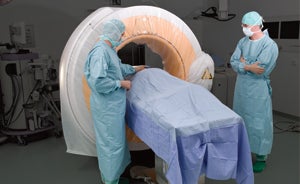
The most exacting moment during surgeries of the spine, head or neck is when the neurosurgeon aligns his surgical instruments to the precise area in the patient’s anatomy where hardware or implants must be placed. Until now, they have placed screws or other hardware in those areas of the body guided by CT scans, MRI’s or x-rays taken prior to surgery. New technology has dramatically improved this process and has made the placement of the necessary hardware more efficient and precise.
Ochsner Lafayette General Medical Center is one of the only health care facilities in Lafayette to offer surgeons the revolutionary Medtronic O-arm Surgical Imaging System, a mobile x-ray machine that provides surgeons with a 360-degree scan of the patient’s changing anatomy while in the operative position.
In the operating room, the O-arm forms a ring around the patient’s body. The ring can be opened and closed so the patient does not have to be moved. It rotates to take 2-D real-time moving x-rays and 3-D images of the body. The O-arm includes a navigational component, like a GPS system, that allows the surgeon to track and guide instruments through the body in real time, ensuring the placement of hardware more precisely.
The navigation system converts the 3-D image on the O-arm into a transparent image, like an x-ray. The system provides images of the anatomy, including bones and implants. It is especially advantageous in cases where large areas need to be visualized. The processing is fast, capturing the entire cervical spine in one 13-second scan. In less than 30 seconds, the O-arm can take almost 400 images, which are reconstructed on a flat-panel monitor for the patient’s surgeon to review during the procedure. These images provide immediate confirmation, before closing the patient, that the hardware or implant has been positioned in its optimal location, possibly avoiding a revision surgery. The greater accuracy afforded by the O-arm means a less invasive, faster procedure with noted quicker recovery times and improved patient outcomes.


